BEEF
Beef has long been a protein staple that has been incorporated into almost every culture in the world. With its many nutritional benefits and rich flavor profile, it’s hard to go wrong adding it in to your meals. Whether you’re new to cooking or want to refine your knowledge of beef cuts, we’ve created this handy guide so you can choose the perfect cut and cooking method for any dish you desire. This guide will help to explain the location of major beef cuts, which cuts are considered the best as well as the most reliable ways to cook each one.
THE BASICS OF BEEF CUTS

Beef is divided into large sections called primal cuts, which you can see in our beef cuts chart. These primal beef cuts, or "primals," are then broken down further into "food-service cuts." These are then chopped into individual steaks, roasts, and other retail cuts.
A side of beef is literally one side of the beef carcass that is split through the backbone. Each side is then halved between the 12th and 13th ribs. These sections are called the forequarter (front of the cow) and the hindquarter (back of the cow).
The most tender cuts of beef are the ones farthest from the horn and hoof. The toughest areas of the animal are the shoulder and leg muscles because they are worked the most.
FOREQUARTER CUTS: BEEF CHUCK
Beef chuck comes from the forequarter. Consisting of parts of the neck, shoulder blade, and upper arm, beef chuck produces tough but very flavorful cuts of meat.
This primal cut has a good deal of connective tissue. That makes chuck a good choice for braised dishes like beef stew or pot roast, both of which tenderize tough cuts. Due to its fat content, beef chuck is also excellent for making ground beef that produces juicy burgers.
The classic 7-bone roast comes from the beef chuck, as do the increasingly popular flat iron steak and Denver steak.
With conventional butchering, the beef chuck is separated from the rib primal between the fifth and sixth ribs. This means that it also contains a few inches of the longissimus dorsi muscle, which is the same tender muscle that rib eye steaks are made from.
COOKING TIPS FOR FLAT IRON STEAK:
Cook 8 – 10 min on direct medium heat (350°F – 450°F), turning once.
FOREQUARTER CUTS: BEEF RIB

Made from the top part of the center section of rib—specifically the sixth through the twelfth ribs— the beef rib primal cut is used for the traditional standing rib roast (also called prime rib). It's also the source of the delectable ribeye steak as well as the classic French entrecôte.
Since they're already tender, steaks and roasts from the beef rib primal can undergo various forms of dry-heat cooking and remain tender. That means you can easily grill, fry, broil, roast, or barbecue these cuts.
It's nearly impossible to describe a beef primal cut without discussing adjacent cuts. In this case, the beef rib primal is situated directly above the beef plate. Exactly where it's divided is somewhat arbitrary. Nevertheless, the lower parts of those ribs—whether we attribute them to the rib primal or the plate primal—are where beef short ribs come from.
COOKING TIPS FOR RIBEYE:
For a 1 ½ inch cut, sear 6 – 8 min on direct high heat (450°F – 550°F), turning once; and grill for 4 – 6 min indirect on high heat.
FOREQUARTER CUTS: BEEF PLATE
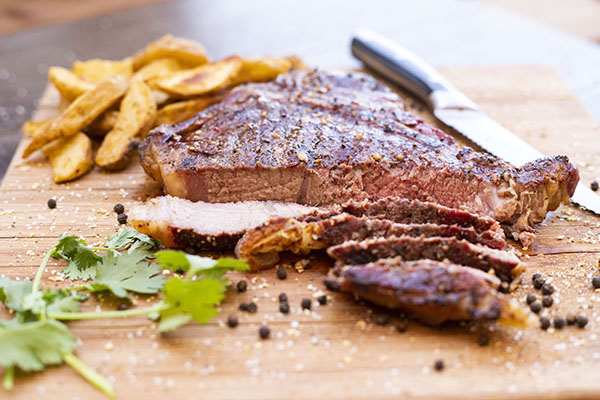
Also called the short plate (or "long plate" depending on where it's separated from the rib primal above it), the beef plate primal includes the short ribs. It is also where the skirt steak is located, which is used in carne asada, a grilled Mexican dish of spicy marinated steak strips.
Skirt steak is the diaphragm muscle. It's attached to the inside abdominal wall by a system of thick connective tissue, which needs to be carefully trimmed away. This steak is extremely flavorful. It's also a thin piece of meat, allowing you to cook it very quickly over high heat. Just don't overcook it. Since it has coarse muscle fibers, be sure to slice it against the grain or it will be chewy.
Beef plate contains a lot of cartilage, especially around the ribs, which is why beef short ribs are ideal for braising. This process of cooking with moist heat at a low temperature will dissolve cartilage and turn it into gelatin.
The beef plate is also fairly fatty, so it can be used in making ground beef. If you're concerned about how lean your beef is, mix it with ground beef from another cut.
COOKING TIPS FOR SKIRT STEAK:
Sear 2 – 3 min on direct medium heat (350°F – 450°F), turning once.
FOREQUARTER CUTS: BEEF BRISKET
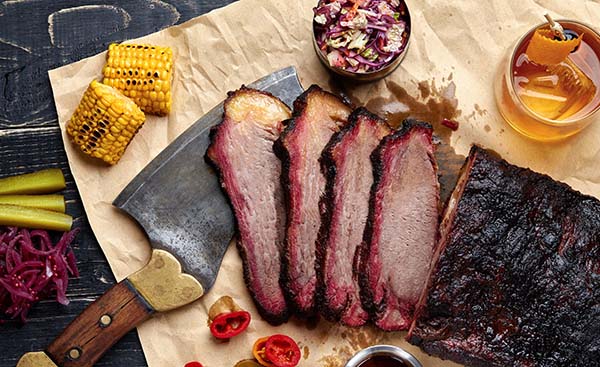
Beef brisket is one of the most flavorful cuts of meat, although it is tough and needs to be cooked in just the right way. It's also a moderately fatty cut of beef, but this can work to your advantage because it tenderizes into succulent, meaty perfection.
Taken from the area around the breastbone, the brisket is basically the chest or pectoral muscle of the animal. The characteristically thick, coarse-grained meat needs a lot of time and low-temperature cooking to break down and tenderize
Brisket is frequently used for making pot roast, and it's the traditional choice for corned beef. Another very popular technique for preparing brisket is to slow cook it in a barbecue or smoker.
COOKING TIPS FOR BEEF BRISKET:
- Start smoking a 12 to 13 pound brisket at 225°F until the internal temperature reads 165°F, about 8 hours.
- Then, remove from the grill and wrap in butcher paper. Make sure to folding the edges down to form a leakproof seal. Return to the smoker for another 5-8 hours, or until the internal temperature reaches 195°F to 203°F.
- When finished, allow the brisket to rest for at least 1 hour before slicing.
FOREQUARTER CUTS: BEEF SHANK
The beef shank is the leg of the animal's thigh. Each side of beef has two shanks, one in the forequarter and one in the hindquarter. It is extremely tough and full of connective tissue.
Beef shank is used in making the luxurious Italian dish osso buco.
COOKING TIPS FOR BEEF SHANK
Brown the edges in oil and simmer for 6-8 hours in moist heat.
HINDQUARTER CUTS: BEEF SHORT LOIN
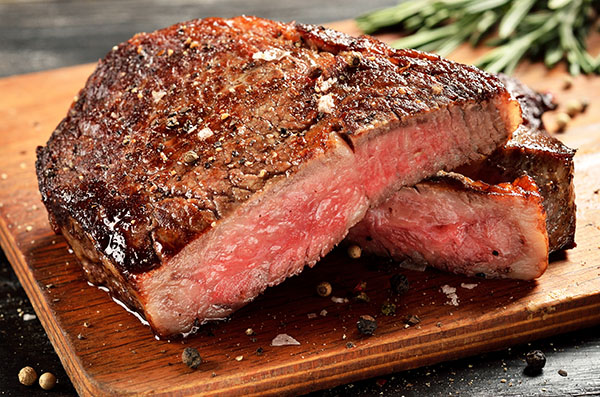
Moving on to the beef primal cuts from the hindquarter, or back of the animal, the short loin is where we find the most desirable cuts of meat. These include T-bone and porterhouse steaks, as well as the strip loin or strip steak.
The beef short loin is only about 16 to 18 inches long. It will yield anywhere from 11 to 14 steaks, depending on thickness.
The steaks from the short loin are cut starting at the rib end and working toward the rear. The first-cut steaks are club steaks or bone-in strip steaks. The center-cut steaks are T-bones, of which there may be six or seven. Finally, a butcher may be able to get two or three porterhouse steaks at the sirloin end.
The tenderloin extends from the short loin back into the sirloin. It's interesting to note that if the tenderloin is removed, there can be no T-bone or porterhouse steaks. Both steaks include a section of the tenderloin muscle.
Dry-heat cooking is best for the tender cuts from the short loin. They're excellent when grilled or fried and only lightly seasoned so you can enjoy the meat's full flavor.
COOKING TIPS FOR NEW YORK STRIP STEAK
For a 1 ½ inch cut, sear 6 – 8 min on direct high heat (450°F – 550°F), turning once; and grill for 4 – 6 min indirect on high heat.
Hindquarter Cuts: Beef Sirloin
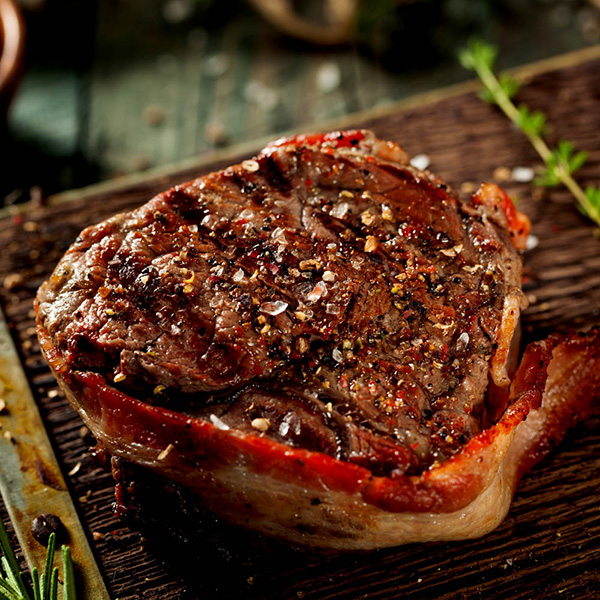
Beef sirloin is another large section of the carcass that runs from the 13th rib all the way back to the hip bone and from the backbone clear down to the flank (or belly).
The full sirloin is itself subdivided into top sirloin and bottom sirloin. Top sirloin is generally fabricated into steaks that are good for grilling. Since the sirloin is closer to the rear leg of the animal, the muscles get a bit tougher. Still, a first-cut sirloin steak—sometimes called a pin-bone steak because it includes a section of the hip bone—is very similar to a porterhouse.
After separating it from the top sirloin, the bottom sirloin is usually divided into three main components: the tri-tip, ball tip and flap, which do well with roasting and barbecuing (and they are sometimes made into ground beef).
Although it's not obvious in a two-dimensional diagram, the back end of the tenderloin, called the butt tender, is also situated within the sirloin, and it's either removed altogether when fabricating a whole tenderloin, or the back end is sold as a roast. (This is almost always because the front end of the tenderloin was left in the short loin to make Porterhouse steaks.) However, beware of butchers who use the name filet mignon to describe a butt tender, because that comes from the completely other end of the tenderloin.
Cooking Tips for Top Sirloin:
For a 1 ½ inch cut, sear 6 – 8 min on direct high heat (450°F – 550°F), turning once; and grill for 4 – 6 min indirect on high heat.
Hindquarter Cuts: Beef Sirloin
The most tender cut of beef is the beef tenderloin and it is found within the loin. This is where we get filet mignon, which is made from the very tip of the pointy end of the tenderloin. Chateaubriand is made from the center cut of the tenderloin.
The tenderloin extends from the short loin into the sirloin. The pointy end is actually situated within the short loin, and the section in the sirloin is sometimes called the butt tenderloin. Even so, butchers will often remove the entire tenderloin and sell it whole or as individual steaks and roasts.
Beef tenderloin should only be cooked using dry-heat methods, such as grilling and broiling. The meat is already super tender, so long cooking times are unnecessary. Keep it quick and the heat high.
Cooking Tips for Filet Mignon:
For a 1 ½ inch cut, sear 6 – 8 min on direct high heat (450°F – 550°F), turning once; and grill for 4 – 6 min indirect on high heat.
Hindquarter Cuts: Beef Flank
Beef flank can be cooked on the grill. Since it has tough muscle fibers, it can get even tougher if it's overcooked, so be careful. The best technique for flank steak is to grill it quickly at a very high temperature. Marinating the meat first can help prevent it from drying out, but avoiding overcooking really is the best prevention. When you're ready to serve it, remember to slice this steak thinly against the grain so it isn't chewy.
Beef flank is also good for braising and it's often used for making ground beef.
Cooking Tips for a Flank Steak:
For a ¾ inch cut, cook 8 – 10 min on direct medium heat (350°F – 450°F), turning once.
Hindquarter Cuts: Beef Round
The beef round primal cut basically consists of the back leg of the steer. Muscles from the round are fairly lean, but they're also tough because the leg and rump get a lot of exercise.
Just like the sirloin primal is separated into two subprimals, top sirloin and bottom sirloin, beef round likewise consists of multiple subprimal cuts: the top round (inside round), bottom round (outside round), and the knuckle. The bottom round is where we get rump roast and eye of round.
Although you might braise a piece of beef round out of necessity, chuck always produces a more delicious piece of meat. There's a good reason for this.
The top round and bottom round are lean and don't contain much collagen. Collagen is the type of protein that turns into gelatin when it's braised slowly. This means that braised rump roast isn't as succulent as braised chuck roast.
More often than not, the best use of round roasts is to roast them slowly so they turn out medium rare. They can then be sliced thinly and used for sandwiches or even served as roasts. Slicing thinly and against the grain is crucial in making them tender enough to eat and enjoy.
Cooking Tips for Beef Round:
Start your roast at 450°F until brown on the outside then reduce temp to 325°F and cook until the internal temperature reaches 135°F to 140°F.
Cook Any Type of Beef Cut on a Pit Boss Grill
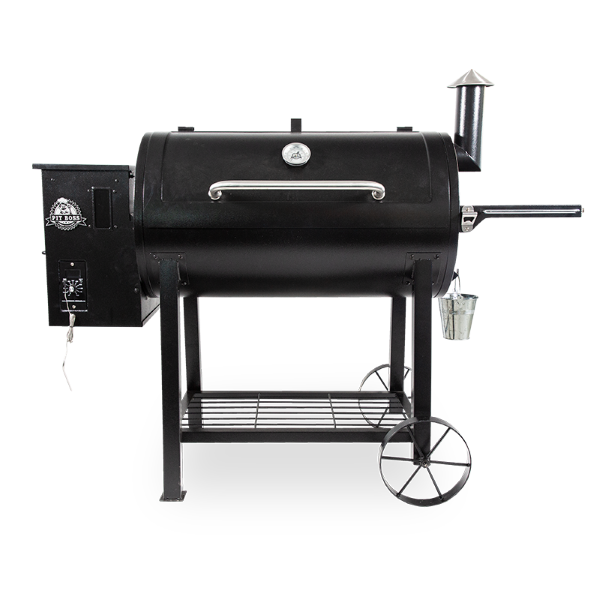
Whether you need to cook a brisket low and slow or reverse sear a ribeye steak, Pit Boss Grills give you eight different cooking methods to choose from. Preview our wood pellet grills for sale and see why they’re Bigger. Hotter. Heavier than the competition.
"Pit Boss is the pellet smoker with the best value per square inch on the market right now." - Simply Meat Smoking - for Grills, Smokers & BBQs information